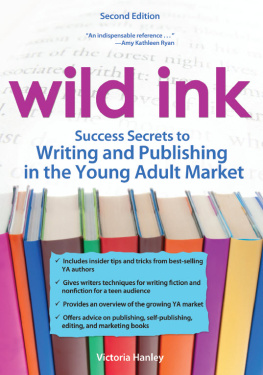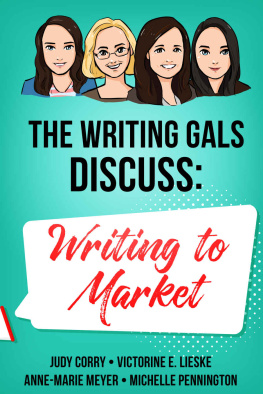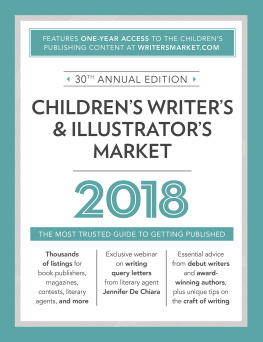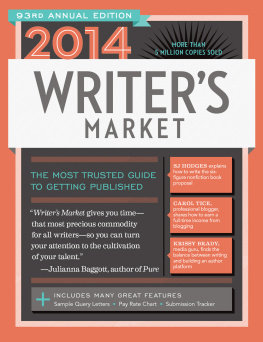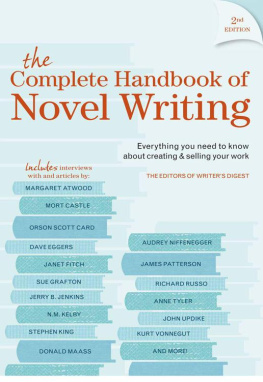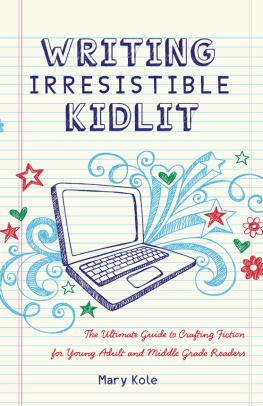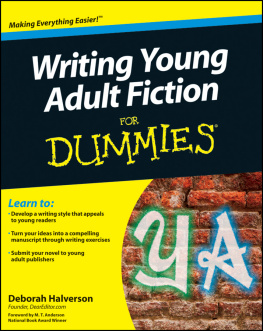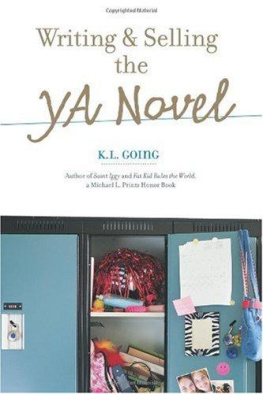wild ink
Success Secrets to
Writing and Publishing
in the Young Adult Market
Second Edition
wild ink
Success Secrets to
Writing and Publishing
in the Young Adult Market
Victoria Hanley

PRUFROCK PRESS INC.
WACO, TEXAS
Copyright 2012 Prufrock Press Inc.
Edited by Lacy Compton
Cover and layout design by Raquel Trevino
ISBN-13: 978-1-59363-996-9
No part of this book may be reproduced, translated, stored in a retrieval system, or transmitted, in any form or by any means, electronic, mechanical, photocopying, microfilming, recording, or otherwise, without written permission from the publisher.
At the time of this books publication, all facts and figures cited are the most current available. All telephone numbers, addresses, and website URLs are accurate and active. All publications, organizations, websites, and other resources exist as described in the book, and all have been verified. The author and Prufrock Press Inc. make no warranty or guarantee concerning the information and materials given out by organizations or content found at websites, and we are not responsible for any changes that occur after this books publication. If you find an error, please contact Prufrock Press Inc.
 | Prufrock Press Inc.
P.O. Box 8813
Waco, TX 76714-8813
Phone: (800) 998-2208
Fax: (800) 240-0333
http://www.prufrock.com |
dedication
To youand your success as a writer
acknowledgments
Great thanks to my editors, Lacy Compton and Cheryl Miller Thurston. Thanks to Raquel Trevino for designing the cover. Big gratitude to my husband Tim, who put up with all the weekends and holidays I spent writing. Thanks to my kids, Emrys and Rose, for being a perpetual source of inspiration and the gleam in my eye. Thanks also to workshop participants far and wide, for providing buckets of fun and motivation. And gratitude beyond measure for my friends Rebecca Rowley, Lisa Pere, and Jeannie Mobley, who read over drafts of this book and contributed insights. Katharine Gregory, Laurel Lagoni, Bob McDonnell, and Elissa Tivona also read excerpts and offered helpful comments. Thank you Diane Tuccillo, Sue-Ellen Jones, and Mary McCarthy, for using your skills as teen librarians to assist me with reference questions, and your skills as remarkable human beings to bring a sense of possibility to this project. And to all of the wonderful writers, editors, and agents who contributed interviews and excerpts for this bookthank you for your time, your expertise, and your help.
table of contents
chapter 1
The YA Genre and You
chapter 2
Getting Your Book in Shape: Novel Writing, Part 1
chapter 3
Getting Your Book in Shape: Novel Writing, Part 2
chapter 4
Writing YA Nonfiction
chapter 5
Obstacles and Demons
chapter 6
Resources for Writers
chapter 7
Submitting Your Manuscript
chapter 8
Getting Your Book Traditionally Published
chapter 9
Marketing Your Book
chapter 10
Self-Publishing Your Book
chapter 11
Interviews With YA Authors
Introduction
This edition of Wild Ink has three new chapters: two on novel writing and another on writing YA nonfiction. Other chapters have been revised and updated, and additional interviews with authors, editors, and agents are included.
Originally, this book grew out of workshops Ive given at writing conferences. The young adult (YA) market is flourishing, and eager workshop participants have been full of questionsso many questions it would take a book to answer them all.
If youve been wondering whether writing for the YA market is for you, by the end of this book I hope youll have a good idea of whether the answer is yes or no. Besides offering plenty of down-to-earth tips, Wild Ink aims to help you explore unknown territory, tread risky ground, and bring buried dreams into the open.
Write that book!
Victoria Hanley
Chapter 1
The YA Genre
and You
Tell the truth as you know it and
let it fall where it falls.
Chris Crutcher
Is it me, or is the world changing at a blistering pace? Inventions, innovations, discoveries! Much that we take for granted today would have been considered out of this world a short while ago. Things move so fast that when boarding the light rail for a trip across Denver, I sometimes wonder if Ill end up on a spaceship circling the Milky Way.
So how do we keep up? How do we write books relevant to todays young people?
I often remind myself that although the world changes, the spirit of youth is a universal constant. The desire to explore, the need to create new things and new experiences, the urge to express, to discover, to venture into the unknownthese are the marks of youth. Great stories for young adults bring forth that spirit, no matter the setting or circumstances.
Naturally, there are as many reasons to write in the young adult (YA) genre as there are writers who do so. Numerous subgenreswhich well explore in this chaptermake room for scads of stories. The skyor is it the galaxy?is the limit.
Thats where you come in.
who reads young
adult fiction?
The target market for books labeled young adult is ages 1316. However, it may surprise you to learn that people ages 999 read teen books. Seriously. Now, more than ever, YA is not only for teenagers.
A hefty number of adults gravitate to teen fiction because they love the excitement of a well-written book with powerful storylines. Take a look at these statistics from 2010:
According to surveys by the Codex Group, a consultant to the publishing industry, 47 percent of 18- to 24-year-old women and 24 percent of same-aged men say most of the books they buy are classified as young adult. The percentage of female Y.A. fans between the ages of 25 and 44 has nearly doubled in the past four years. Today, nearly one in five 35- to 44-year-olds say they most frequently buy Y.A. books. For themselves. (Paul, 2010, para. 5)
The reading trends reported in Pauls essay still pertain. If anything, the percentage of adults reading and buying YA books has increased. Current indications from librarians, fellow authors, and my own e-mails say that its at least 50% now.
Not only that, but avid readers ages 912 are also eager for stories that go beyond the middle grade (MG) category. This group forms an enthusiastic but smaller cheering section for YA novels.
With such a wide readership, what really distinguishes the young adult genre from books found in the main section of the library or bookstore?
definition of ya fiction
In general, YA novels move at a brisk pace. Everythings a bit more condensed and intense than in traditional adult novels. As a writer, youll want to aim for a style that moves forward quickly and emphasizes voice. (More about voice in Chapter 3.)
Word Count
Page requirements for teen titles used to be strict. Between 50,000 and 60,000 words was the norm, but those requirements have loosened up, and now teen books can range from just short of 100 pages to more than 600. A quick look at page counts in my latest stack of YA novels checked out from the library reveals that the average is 325. The shortest book is 135 pages, and the longest is 405. A 325-page book is approximately 80,000 words, depending on how much dialogue is included. By comparison, the average adult novel has more than 100,000 words.
Next page
